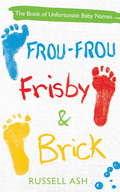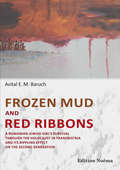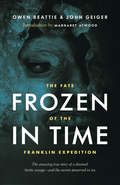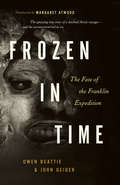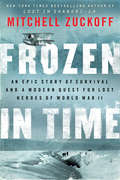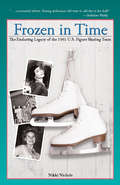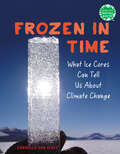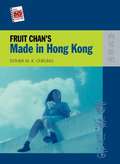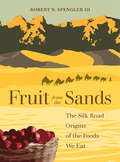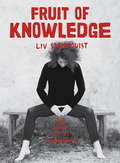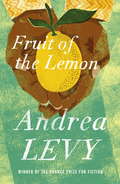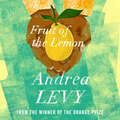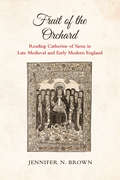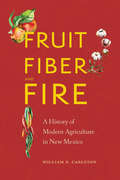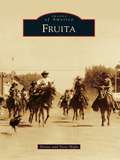- Table View
- List View
Frou-Frou, Frisby & Brick: The Book of Unfortunate Baby Names
by Russell AshFrou-Frou Mallett Extravaganza Tomkyns-Grafton Maniac Keene Reckless Baker If there's one thing guaranteed to make a child shrink into their seat during registration - it's a stupid name. Unfortunately for kids across the world, parents keeping making crimes against nomenclature. Fortunately for us, Russell Ash keeps collecting them. The perfect gift book for expectant parents, FROU-FROU, FRISBY & BRICK is a helpful guide to the sorts of names, or name combinations, to avoid at all costs.
Frou-Frou, Frisby & Brick: The Book of Unfortunate Baby Names
by Russell AshFrou-Frou MallettExtravaganza Tomkyns-GraftonManiac KeeneReckless BakerIf there's one thing guaranteed to make a child shrink into their seat during registration - it's a stupid name. Unfortunately for kids across the world, parents keeping making crimes against nomenclature. Fortunately for us, Russell Ash keeps collecting them.The perfect gift book for expectant parents, FROU-FROU, FRISBY & BRICK is a helpful guide to the sorts of names, or name combinations, to avoid at all costs.
Frozen
by Mary CasanovaSixteen-year-old Sadie Rose hasn&’t said a word in eleven years—ever since the day she was found lying in a snowbank during a howling storm. Like her voice, her memories of her mother and what happened that night were frozen. Set during the roaring 1920s in the beautiful, wild area on Rainy Lake where Minnesota meets Canada, Frozen tells the remarkable story of Sadie Rose, whose mother died under strange circumstances the same night that Sadie Rose was found, unable to speak, in a snowbank. Sadie Rose doesn&’t know her last name and has only fleeting memories of her mother—and the conflicting knowledge that her mother had worked in a brothel. Taken in as a foster child by a corrupt senator, Sadie Rose spends every summer along the shores of Rainy Lake, where her silence is both a prison and a sanctuary.One day, Sadie Rose stumbles on a half dozen faded, scandalous photographs—pictures, she realizes, of her mother. They release a flood of puzzling memories, and these wisps of the past send her at last into the heart of her own life&’s great mystery: who was her mother, and how did she die? Why did her mother work in a brothel—did she have a choice? What really happened that night when a five-year-old girl was found shivering in a snowbank, her voice and identity abruptly shattered?Sadie Rose&’s search for her personal truth is laid against a swirling historical drama—a time of prohibition and women winning the right to vote, political corruption, and a fevered fight over the area&’s wilderness between a charismatic, unyielding, powerful industrialist and a quiet man battling to save the wide, wild forests and waters of northernmost Minnesota. Frozen is a suspenseful, moving testimonial to the haves and the have-nots, to the power of family and memory, and to the extraordinary strength of a young woman who has lost her voice in nearly every way—but is utterly determined to find it again.
Frozen Chosin: U.S. Marines At The Changjin Reservoir [Illustrated Edition] (Marines In The Korean War Commemorative Series #7)
by Brigadier General Edwin H. SimmonsIncludes more than 40 maps, plans and illustrations.This volume in the official History of the Marine Corps chronicles the part played by United States Marines in the Chosin Reservoir Campaign.The race to the Yalu was on. General of the Army Douglas MacArthur's strategic triumph at Inchon and the subsequent breakout of the U.S. Eighth Army from the Pusan Perimeter and the recapture of Seoul had changed the direction of the war. Only the finishing touches needed to be done to complete the destruction of the North Korean People's Army. Moving up the east coast was the independent X Corps, commanded by Major General Edward M. Almond, USA. The 1st Marine Division, under Major General Oliver P. Smith, was part of X Corps and had been so since the 15 September 1950 landing at Inchon.After Seoul the 1st Marine Division had reloaded into its amphibious ships and had swung around the Korean peninsula to land at Wonsan on the east coast. The landing on 26 October 1950 met no opposition; the port had been taken from the land side by the resurgent South Korean army. The date was General Smith's 57th birthday, but he let it pass unnoticed. Two days later he ordered Colonel Homer L. Litzenberg, Jr., 47, to move his 7th Marine Regimental Combat Team north from Wonsan to Hamhung. Smith was then to prepare for an advance to the Manchurian border, 135 miles distant. And so began one of the Marine Corps' greatest battles--or, as the Corps would call it, the "Chosin Reservoir Campaign." The Marines called it the "Chosin" Reservoir because that is what their Japanese-based maps called it. The South Koreans, nationalistic sensibilities disturbed, preferred--and, indeed, would come to insist--that it be called the "Changjin" Reservoir.
Frozen Earth: The Once and Future Story of Ice Ages
by Doug MacdougallIn this engrossing and accessible book, Doug Macdougall explores the causes and effects of ice ages that have gripped our planet throughout its history, from the earliest known glaciation--nearly three billion years ago--to the present. Following the development of scientific ideas about these dramatic events, Macdougall traces the lives of many of the brilliant and intriguing characters who have contributed to the evolving understanding of how ice ages come about. As it explains how the great Pleistocene Ice Age has shaped the earth's landscape and influenced the course of human evolution, Frozen Earth also provides a fascinating look at how science is done, how the excitement of discovery drives scientists to explore and investigate, and how timing and chance play a part in the acceptance of new scientific ideas. Macdougall describes the awesome power of cataclysmic floods that marked the melting of the glaciers of the Pleistocene Ice Age. He probes the chilling evidence for "Snowball Earth," an episode far back in the earth's past that may have seen our planet encased in ice from pole to pole. He discusses the accumulating evidence from deep-sea sediment cores, as well as ice cores from Greenland and the Antarctic, that suggests fast-changing ice age climates may have directly impacted the evolution of our species and the course of human migration and civilization. Frozen Earth also chronicles how the concept of the ice age has gripped the imagination of scientists for almost two centuries. It offers an absorbing consideration of how current studies of Pleistocene climate may help us understand earth's future climate changes, including the question of when the next glacial interval will occur.
Frozen Earth: The Once and Future Story of Ice Ages
by Douglas MacdougallDoug Macdougall explores the causes and effects of ice ages that have gripped our planet throughout its history, from the earliest known glaciations -- nearly three billion years ago -- to the present.
Frozen Mud and Red Ribbons: A Romanian Jewish Girl's Survival through the Holocaust in Transnistria and Its Rippling Effect on the Second Generation (Edition Noema Ser.)
by Avital E. BaruchWhen Sophica was six years old, she was deported together with her mother and the whole of the Jewish community of Mihaileni, Romania to a strip of land in Eastern Ukraine called Transnistria. Death, illness, brutality, and shame became her daily life. Hungry and afraid, she held on to her sanity and hope, albeit losing her sister and her father and witnessing a vicious attack on her mother. She met Herman on her way to the Promised Land. Herman didn't mind wearing the yellow star and staying home from school. He played outside with his friends while his father and brother were sent to a labor camp. After the war ended, he joined a Jewish youth movement and embarked on a ship to Israel. However, his journey was interrupted and he was taken to a British detention camp in Cyprus where he met Sophica. They were renamed Shulamit and Tzvi and made a home together in Israel. Shulamit/Sophica never mentioned her sad childhood. Sixty-five years after the war and her deportation, Sophica's daughter comes across a family secret and starts asking questions, inducing Shulamit to break her silence and become the frightened little Sophica once more. This book tells her moving story.
Frozen in Time
by John Geiger Owen BeattieThe Franklin expedition was not alone in suffering early and unexplained deaths. Indeed, both Back (1837) and Ross (1849) suffered early onset of unaccountable "debility" aboard ship and Ross suffered greater fatalities during his single winter in the Arctic than did Franklin during his first. Both expeditions were forced to retreat because of the rapacious illness that stalked their ships. Frozen in Time makes the case that this illness (starting with the Back expedition) was due to the crews' overwhelming reliance on a new technology, namely tinned foods. This not only exposed the seamen to lead, an insidious poison - as has been demonstrated in Franklin's case by Dr. Beattie's research - but it also left them vulnerable to scurvy, the ancient scourge of seafarers which had been thought to have been largely cured in the early years of the nineteenth century. Fully revised, Frozen in Time will update the research outlined in the original edition, and will introduce independent confirmation of Dr. Beattie's lead hypothesis, along with corroboration of his discovery of physical evidence for both scurvy and cannibalism. In addition, the book includes a new introduction written by Margaret Atwood, who has long been fascinated by the role of the Franklin Expedition in Canada's literary conscience, and has made a pilgrimage to the site of the Franklin Expedition graves on Beechey Island.
Frozen in Time
by Margaret Atwood John Geiger Owen BeattieThe truth about what happened on Sir John Franklin's ill-fated Arctic expedition of 1845-48 has been shrouded in mystery for 165 years. Carrying the best equipment that the science and technology, Franklin and his men set out to "penetrate the icy fastness of the north, and to circumnavigate America." The expedition's two ships - HMS Erebus and HMS Terror - carrying 129 officers and men, disappeared without a trace. From 1846 to 1880 more than 20 major rescue parties were involved in the search for the missing men and ships. The disappearance of the expedition and absence of any substantial written accounts of the journey have left attempts at a reconstruction of events sketchy and inconclusive. In Frozen in Time, forensic anthropologist Owen Beattie and historian John Geiger tell the dramatic story of the excavation of three sailors from the Franklin Expeditions, buried for 138 years on the lonely headland of Beechey Island. This book contains the astonishing photographic record of the excavation, together with the maps and illustrations that accompany this riveting account of Franklin's fatal adventure. The unfolding of Dr. Beattie's unexpected findings is not only a significant document but also, in itself, a tale of high adventure.
Frozen in Time
by Margaret Atwood John Geiger Owen BeattieThe revised text of "Frozen in Time" expands on the history of nineteenth century British Arctic exploration and specifically the Franklin expedition, placing it in the context of other expeditions of the era, including those commanded by George Back and James Clark Ross.The Franklin expedition was not alone in suffering early and unexplained deaths. Indeed, the expeditions of both Back (1837) and Ross (1849) were forced to retreat because of the rapacious illness that stalked their ships. The authors make the case that this illness was due to the crews' overwhelming reliance on a new technology: tinned foods. This not only exposed the seamen to lead, an insidious poison, but also left them vulnerable to scurvy.The revised "Frozen in Time" will also update the research outlined in the original edition, and will introduce independent confirmation of Dr. Beattie's lead hypothesis, along with corroboration of his discovery of physical evidence for both scurvy and cannibalism. In addition, the book includes a new introduction written by Margaret Atwood, who has long been fascinated by the role of the Franklin Expedition in Canada's literary conscience.Includes never before seen photographs from the exhumations on Beechey Island and rarely seen historical illustrations.
Frozen in Time
by Mitchell ZuckoffThe author of the best-selling Lost in Shangri-La recounts the November 1942 crash of a U. S. cargo plane into the Greenland Ice Cap, the loss of the B-17 sent to find it, and the loss of a Grumman Duck amphibious plane that had managed to rescue one B-17 crew member. The remaining crew endured 148 days of Arctic winter before finally being rescued. With a 200,000-copy first printing.
Frozen in Time
by Nikki NicholsOn February 15, 1961, all 18 members of the U.S. World Figure Skating Team were killed in a plane crash, along with 16 coaches, officials, and family members. Frozen in Time takes readers inside the lives of the young skaters who died in the crash, revealing their friendships, romances, rivalries, sacrifices, and triumphs. The dramatic focus lingers on two families of powerful women: the Owens and the Westerfelds. Maribel Owen, the most famous woman in figure skating at the time, relentlessly drives her two young daughters-pairs champion Mara and the spectacular Laurence, who graced the cover of Sports Illustrated on the day she died. Myra Westerfeld, meanwhile, loses her marriage while guiding her daughters Sherri and Steffi to the pinnacle of the sport. Along with the bittersweet personal stories, author Nikki Nichols recounts the U.S. skating program's lengthy struggle to rebuild after this devastating accident.
Frozen in Time: A Minnesota North Stars History
by Adam RaiderIn 1967 the National Hockey League decided to double its size from six teams to twelve. This expansion was the first of its kind, and Minnesota, with its rich hockey history, was a natural choice for a new franchise. Thus the Minnesota North Stars were born.Frozen in Time examines the organization’s signature seasons, from the late 1970s, when the club was at its worst, to its two surprising runs to the Stanley Cup Finals. The book recalls the exploits of characters such as Wren Blair, the firebrand ex-scout who would become the team’s first coach and general manager, and owner Norm Green, the man who moved the team to Texas in 1993, making him one of the most hated men in Minnesota. Here, too, is the tragic story of Bill Masterton, an original North Star whose death in 1968 as the result of an on-ice injury remains the only one in the history of the league. The team’s engaging history is brought to life with vivid recollections from former players and legends, including Cesare Maniago, Tom Reid, and Bobby Smith, and from journalists, broadcasters, front office executives, and faithful fans. Also including season-by-season summaries, player profiles, and statistics, Frozen in Time offers an authoritative and nostalgic look at Minnesota’s still-beloved North Stars and a bygone era of pro hockey.
Frozen in Time: What Ice Cores Can Tell Us About Climate Change (Books for a Better Earth)
by Carmella Van VleetA dazzling introduction to paleoclimatology for kids, connecting the methods that scientists use to study our climate history with future climate change solutions.Believe it or not, ice isn&’t always just frozen water. In fact, most of the ice covering our planet contains thousands of years' worth of information about our atmosphere. This ice is made up of a lot more than snow—it has soot, volcanic ash, gasses, and other substances that affect the climate. And if we drill a piece of that ice? We get a frozen time capsule, courtesy of Earth. In this exhilarating middle grade nonfiction book by a former educator, kids are immersed in the field of paleoclimatology. Readers go along on an ice core expedition, run through each step in the collecting and transporting process, review the fascinating components of an ice core, and explore the specialized labs where scientists examine them.But these pieces of our planet are more than just cool records. By preserving and studying these frosty collections of climate history, we can learn from previous patterns and better protect our planet in the future. The final chapter focuses on ice as a key tool in the fight against climate change.With crystal-clear explanations and an engaging, kid friendly tone, the book features 15+ full-color photographs, diagrams, interviews with paleoclimatologists, a glossary of terms, and simple experiments for budding scientists at home. Books for a Better Earth are designed to inspire children to become active, knowledgeable participants in caring for the planet they live on.A Junior Library Guild Gold Standard Selection
Fruit Chan's Made in Hong Kong
by Esther M. K. CheungThis tragic coming-of-age story follows three disillusioned local youths struggling to navigate Hong Kong public housing projects and late adolescence amid violent crime, gang pressure, and broken homes. Their personal friendships and family lives intersect with a mysterious fourth protagonist, a girl whose suicide haunts the other three throughout the film as they move toward their own premature ends. This 1997 film was the first in Chan's acclaimed "handover trilogy." Shot on a very low budget, utilizing excess film stock, amateur actors, and a crew of five, it marked the beginning of Chan's career as an independent film director.
Fruit from the Sands: The Silk Road Origins of the Foods We Eat
by Robert N. Spengler IIIThe foods we eat have a deep and often surprising past. From almonds and apples to tea and rice, many foods that we consume today have histories that can be traced out of prehistoric Central Asia along the tracks of the Silk Road to kitchens in Europe, America, China, and elsewhere in East Asia. The exchange of goods, ideas, cultural practices, and genes along these ancient routes extends back five thousand years, and organized trade along the Silk Road dates to at least Han Dynasty China in the second century BC. Balancing a broad array of archaeological, botanical, and historical evidence, Fruit from the Sands presents the fascinating story of the origins and spread of agriculture across Inner Asia and into Europe and East Asia. Through the preserved remains of plants found in archaeological sites, Robert N. Spengler III identifies the regions where our most familiar crops were domesticated and follows their routes as people carried them around the world. With vivid examples, Fruit from the Sands explores how the foods we eat have shaped the course of human history and transformed cuisines all over the globe.
Fruit of Knowledge
by Liv Strömquist'How I loved reading Fruit of Knowledge ... Clever, angry, funny and righteous, also informative to an eye-popping degree' Rachel Cooke, OBSERVER GRAPHIC NOVEL OF THE MONTHFrom Adam and Eve to pussy hats, people have punished, praised, pathologised and politicised vulvas, vaginas, clitorises, and menstruation. In the international bestseller Fruit of Knowledge, celebrated Swedish cartoonist Liv Strömquist traces how different cultures and traditions have shaped women's health and beyond. Her biting, informed commentary and ponytailed avatar guides the reader from the darkest chapters of history (a clitoridectomy performed on a five-year-old American child as late as 1948) to the lightest (vulvas used as architectural details as a symbol of protection). Like Alison Bechdel and Jacky Fleming, she uses the comics medium to reveal uncomfortable truths about how far we haven't come.'Just the thing for all the feminists in your life' Observer Books of the Year'This book made me laugh in public (and also cry a little). It is the book I gave to my younger sister the next time I saw her because of its anger and brilliance and because it is an overwhelming source of knowledge about things we should all already know' Daisy Johnson, author of the Man Booker Prize-shortlisted Everything Under 'There are moments of genuine hilarity, as when Strömquist pictures the dinner party chatter of men living under a matriarchy, and others of fierce anger in this wild, witty and vital book' Observer Books of the Year
Fruit of the Lemon
by Andrea LevyA unique novel full of humour, wit and passion from Andrea Levy, critically acclaimed author of the Orange Prize winning SMALL ISLAND and the Man Booker shortlisted THE LONG SONG.Faith Jackson fixes herself up with a great job in TV and the perfect flatshare. But neither is that perfect - and nor are her relations with her overbearing, though always loving family. Furious and perplexed when her parents announce their intention to retire back home to Jamaica, Faith makes her own journey there, where she is immediately welcomed by her Aunt Coral, keeper of a rich cargo of family history. Through the weave of her aunt's storytelling a cast of characters unfolds stretching back to Cuba and Panama, Harlem and Scotland, a story that passes through London and sweeps through continents.
Fruit of the Lemon
by Andrea LevyThe third and most ambitious novel from this unique and acclaimed writer, FRUIT OF THE LEMON establishes Andrea Levy alongside Arundhati Roy and Meera Syal in the first rank of British fiction.Faith Jackson fixes herself up with a great job in TV and the perfect flatshare. But neither is that perfect - and nor are her relations with her overbearing, though always loving family. Furious and perplexed when her parents announce their intention to retire back home to Jamaica, Faith makes her own journey there, where she is immediately welcomed by her Aunt Coral, keeper of a rich cargo of family history. Through the weave of her aunt's storytelling a cast of characters unfolds stretching back to Cuba and Panama, Harlem and Scotland, a story that passes through London and sweeps through continents.(P) 2022 Headline Publishing Group Ltd
Fruit of the Lemon: A Novel
by Andrea LevyA unique novel full of humour, wit and passion from Andrea Levy, critically acclaimed author of the Orange Prize winning SMALL ISLAND and the Man Booker shortlisted THE LONG SONG.Faith Jackson fixes herself up with a great job in TV and the perfect flatshare. But neither is that perfect - and nor are her relations with her overbearing, though always loving family. Furious and perplexed when her parents announce their intention to retire back home to Jamaica, Faith makes her own journey there, where she is immediately welcomed by her Aunt Coral, keeper of a rich cargo of family history. Through the weave of her aunt's storytelling a cast of characters unfolds stretching back to Cuba and Panama, Harlem and Scotland, a story that passes through London and sweeps through continents.
Fruit of the Orchard: Reading Catherine of Siena in Late Medieval and Early Modern England
by Jennifer N. BrownFruit of the Orchard sheds light on how Catherine of Siena served as a visible and widespread representative of English piety becoming a part of the devotional landscape of the period. By analyzing a variety of texts, including monastic and lay, complete and excerpted, shared and private, author Jennifer N. Brown considers how the visionary prophet and author was used to demonstrate orthodoxy, subversion, and heresy. Tracing the book tradition of Catherine of Siena, as well as investigating the circulation of manuscripts, Brown explores how the various perceptions of the Italian saint were reshaped and understood by an English readership. By examining the practice of devotional reading, she reveals how this sacred exercise changed through a period of increased literacy, the rise of the printing press, and religious turmoil.
Fruit, Fiber, and Fire: A History of Modern Agriculture in New Mexico
by William R. CarletonFor much of the twentieth century, modernization did not simply radiate from cities into the hinterlands; rather, the broad project of modernity, and resistance to it, has often originated in farm fields, at agricultural festivals, and in agrarian stories. In New Mexico no crops have defined the people and their landscape in the industrial era more than apples, cotton, and chiles. In Fruit, Fiber, and Fire William R. Carleton explores the industrialization of apples, cotton, and chiles to show how agriculture has affected the culture of twentieth-century New Mexico. The physical origins, the shifting cultural meanings, and the environmental and market requirements of these three iconic plants all broadly point to the convergence in New Mexico of larger regions—the Mexican North, the American Northeast, and the American South—and the convergence of diverse regional attitudes toward industry in agriculture. Through the local stories that represent lives filled with meaningful struggles, lessons, and successes, along with the systems of knowledge in our recent agricultural past, Carleton provides a history of the broader culture of farmers and farmworkers. In the process, seemingly mere marginalia—a farmworker&’s meal, a small orchard&’s advertisement campaign, or a long-gone chile seed—add up to an agricultural past with diverse cultural influences, many possible futures, and competing visions of how to feed and clothe ourselves that remain relevant as we continue to reimagine the crops of our future.
Fruita (Images of America)
by Steve Hight Denise HightWilliam Pabor arrived in Western Colorado before the advent of irrigation, and the land presented a barren and desolate sight. But he saw something entirely different. "In the spring of 1884, lying on the bare floor of a log cabin on the site of what is now the town of Fruita, I watched the moonbeams play on the Roan Cliffs and across Pinon Mesa," Pabor wrote. "The silence of centuries seemed resting upon the plain. . . . But visions of the possibilities of the future swept before me. I saw homes founded, I saw family circles gathered together. I saw vineyards and orchards, and rose-embowered cottages in which love and happiness and contentment abode. . . . I heard the merry voices of children yet to be born. I heard the singing of harvesters bringing in the sheaves of golden grain." Pabor soon turned vision into reality and founded the town of Fruita.
